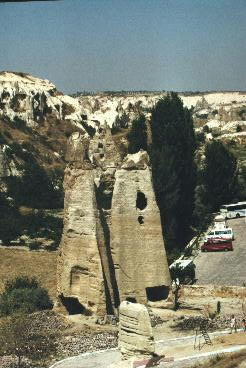
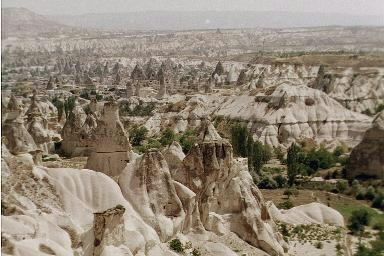
Up in the morning and off to sightsee in Kapadokya.
Humor me for a small geological digression - like I said before, most of the geology of Kapadokya is volcanic, alternating layers of basalt lava flows and volcanic ash deposits (also known as tuff). Now, tuff is much softer and more easily eroded than basalt, and the resulting differential erosion creates truly bizarre landscapes. One of the strangest is when there's acres of tuff columns with little basalt caps on the top of them - the locals call them fairy chimneys (make of that what you will). Here's some pictures to give you an idea of how amazing the topography looks:



The other unique thing about the tuff is that it's soft enough that it's easy to dig into - for thousands of years the people living here have carved out houses, churches, even entire underground cities into the tuff.
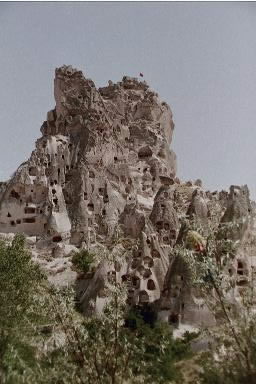
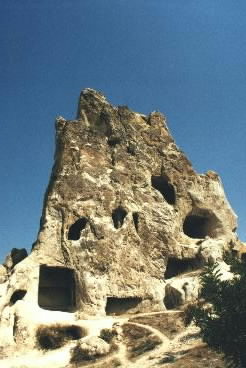
Our first chance to check this out firsthand was the Göreme Open-Air Museum (apparently the Turkish term for a historical site that's not enclosed in a building is an open-air museum). From 800-1100 A.D. (or thereabouts) there was a Christian commune here, and over the years they carved out a dozen or so small chapels and several large living quarters out of the rock. Most of the chapels have frescoes of various religious scenes and local saints (my favorite being the hermaphrodite Saint Onofrius - who according to legend started out being a beautiful female prostitute, but after she got religion was still being accosted by her former clients, so she asked God to make her ugly - he obliged by turning her into a hermaphrodite, complete with beard and breasts. It probably at least discouraged her less kinky former clients :-) The painting of Saint Onofrius went into surprising amounts of anatomical detail - I guess the early Christians were less hung up about nudity and stuff. Sadly, they won't let you take pictures inside the chapels (I'm not sure exactly why - perhaps they're embarrassed that over-eager Muslims had trashed many of the paintings depicting people.)
The site was swarming with Japanese and French tourists (Kapadokya must be a big French tourism place - there were more signs in French than there were in English). Eventually we made our way through most of the chapels and living quarters. A lot of them are falling victim to the elements and getting eroded away. Some dwellings have only the back wall left:

See the little holes in the rock face? Apparently back in those days it was common to keep pigeons in your house - the holes were where the pigeons roosted/nested. Hence, pigeonholes. Well, I thought it was cool...
Our next stop was a Turkish rug factory and showroom. They had a little demo room with a number of women making rugs (one could even try knotting a few strands oneself, and have all the rug-makers laugh at your incompetence :-)
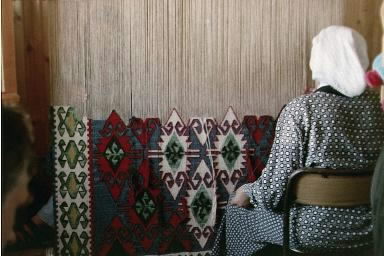

Rug makers in action; Getting the silk from silkworm cocoons
Then we were carted off to the display room and, of course, the sales pitch started. Rug after rug after rug, each more fine (and expensive) than the last was trotted out and unrolled at our feet. My favorites were the undyed rugs - they use only the natural colors of the sheep (as the demo guy said, white sheep, black sheep, and dirty grey sheep :-) Alas, they were a bit too expensive for my budget, but once I expressed a mild interest I had several salesguys attached to me, leechlike, for the remainder of our stay there. (A fair number of our group did buy rugs, so it wasn't like it was a total loss for the rug guys).
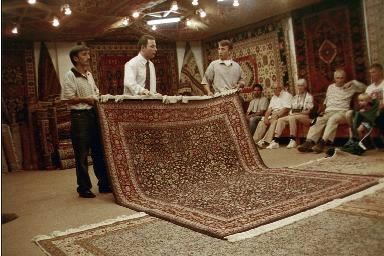

Showing off the wares; Relaxing in the rug showroom (the woman in the picture is
Clare Bolfing, whom EECS Department old-timers might recognize)
After rug-buying and lunch, it was off to one of the underground cities. Back when being a Christian became not very popular around those parts (around 1000-1200 AD, I think) the Christian communities dug these enormous underground systems of linked tunnels and rooms out of the soft tuff, so they'd have someplace defensible to hide when the roving bands of jihad-ers/barbarians/whathaveyou came to town. The one we visited could house *3000* people. This is definitely not a trip I'd recommend to the claustrophobic - the rooms are small and the tunnels are narrow and low. They had an ingenious defense system - each of the several levels was accessible by only a single tunnel, which had a really big millstone-shaped rock which could be rolled in place to completely seal the tunnel and foil any would-be invaders. In addition, there were small holes on the roof of the tunnel which the inhabitants could access to pour boiling oil onto or shoot arrows at said hapless invaders. Naturally, most of Bonnie's pictures from down here didn't turn out very well, except for one looking up a ventilation shaft (the historians aren't sure why the invaders didn't notice the ventilation shafts - clever camouflage, perhaps):

We got back to the hotel in the late afternoon, hot and worn out from all the sightseeing. A dip in the pool seemed in order (thank heavens they had a pool), so we braved the lobby full of chain-smoking French tourists and made our way out to the pool (which, since this was a tourist hotel, had its own bar and music system, so we were serenaded with loud American disco and Turkish pop while we swam). Feeling considerably refreshed, we had a quick dinner and prepared for our big night on the town - the tour company sponsored a trip to a local restaurant/dance club for folk dancing exhibitions, munchies, and all the booze we could drink :-) Sounded somewhat ominous, but hey, you only turn 40 once. (Bonnie was under strict orders not to reveal to anyone that it was my birthday, and she didn't, bless her, no doubt saving me considerable embarrassment.)
On the way there, good ol' Mehmet warned us of the dangers of the local hooch, raki (that i's not supposed to have a dot over it, but as I don't have a Turkish keyboard, you'll have to use your imagination - because of that it's pronounced "rah-kuh", not "rah-key", if you ever want to impress your Turkish-speaking friends with your knowledge of Turkish booze pronunciations). Raki tastes like an anise liqueur, but it has the alcohol content of whisky, which has led to the downfall of many an unsuspecting tourist. I tried some of Bonnie's, but I'm not a big anise fan - I stuck with the local wine instead. The red was actually quite good - it's a pity they don't export it.
The club was carved out of the ever-present tuff (in modern times, though, for the tourist trade). While this meant it was nice and cool inside, it was also surprisingly damp. The promised munchies were fairly paltry (there's only so many raisins and toasted chickpeas you can eat before you're utterly sick of them) so I began to regret not having had more dinner. The booze was plentiful, however.
The folk dancing was all very nice - Turkey is an amalgam of many different cultures, and their dance reflects it. Some of them were the standard middle-eastern grapevine-step stuff, and others were strongly reminiscent of eastern Europe (complete with babushkas, funny fur hats, and cossack pants). Well, Turkey does share a border with Georgia, after all... And, oh yes, they had belly dancers too. The first woman was competent, but nothing out of the ordinary (I've seen better at renaissance fairs). Of course afterwards there was the obligatory audience participation schtick, which was saved from total boredom by the fact that Castor was one of the dancers. The other three of us deeply regretted not having brought any cameras along - I'm sure the future embarrassment factor would have been substantial.
The second belly dancer was dressed in a traditional women's outfit, but before long we began to speculate that it might actually be a guy (the dancer wore a veil, so the Adam's apple check was out). At the end of the dance the veil came off, and, yes, it was a guy, though a surprisingly effeminate one. (most American male belly dancers are considerably more butch) Yet another audience participation segment ensued, this time with the women patrons, and all three of us valiantly resisted the many attempts of the staff to get us out and dancing (thankfully). By this time I was getting seriously bored, had already drunk more wine than I probably should have, and just wanted to go to bed. After the bellydancing bit ended, its was time for audience participation folkdancing, and then just plain old dancing to deafeningly loud Turkish pop. Finally, the guides rounded us all back up and we made our unsteady way back to the hotel.
Last updated 12/22/99 by Jean Richter, richter@eecs.Berkeley.EDU